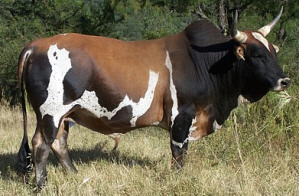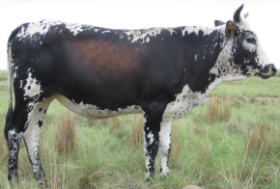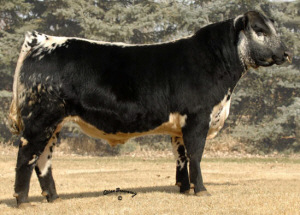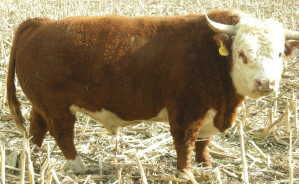



Nguni
History
Nguni cattle derive their name from the black tribes of Africa, collectively known as the Nguni people. Nguni cattle descend from both Bos taurus and Bos indicus cattle and entered Africa around 8000 years ago.
 Photo courtesy of The Nguni Breeders's Society of South Africa, www.ngunicattle.info |
Only in 1932 did the late Professor HH Curzon make an effort to breed true to type Nguni cattle which resulted in the formation of the Bartlow Combine breeding station in the late 1940’s. Another milestone in the recognition of the Nguni breed was the Bonsma report of 1950 on indigenous cattle in South Africa where the appreciation of this adapted breed was highlighted. Final recognition came in 1985 when the Nguni Cattle Breeders Society was accepted as a member of the South African Stud Book and Livestock Improvement Association.
Characteristics
The Nguni is a breed that has adapted to the African environment over many years and therefore displays functional characteristics. It is slightly smaller in size compared to the large beef breeds of other countries but this just enables it to live in the Highveld regions of Africa.
Bulls are medium sized and weigh between 500kg and 600kg. They are muscular and display typical male characteristics with well developed, muscular, cervico-thoracic humps, which mean that the hump is in front of the foreleg. The scrotum is well developed with good pigmentation and thermo-regulatory function.
The cows are small and weigh between 300kg and 400kg. They are feminine with sleek, delicate lines around the neck and forequarter and a prominent wedge shape with the weight in the stomach and hindquarter area. The sloping rump is a distinctive characteristic of the Nguni cow and ensures ease of calving. The udder is small to medium, well attached with small, functional teats.
Horn shapes and hide patterns are varied and no two animals are alike which has its own attraction and the cause of this breed being so distinctive from other breeds.
 Photo courtesy of ZZZ Nguni Stud, www.nguni.info |
Their hide is sleek and glossy to prevent ticks attaching itself to the animal. The legs and hoofs are strong to enable the animal to walk and climb to find enough grazing. The tail is thin and flexible with a full brush and extend to below the hock. The Nguni is known for its good temperament.
Nguni cattle are heat and light tolerant and can handle extreme heat and cold alike. They are adaptable and hardy and possess excellent resistance to internal and external parasites with natural immunity to tick borne diseases. Early maturity, fertility, ease of calving and longevity ensures that cows have long and productive lives, cows will produce 10 or more calves. The cows show great efficiency and often wean calves that weigh 45-50% of their body mass. The average birth weight of calves is 22.5kg and wean at approximately 175kg, they grow at about 0.70 kg per day until weaning.
Nguni cattle are less prone to dystocia, this being ascribed to their sloping rumps, small uterus and low birth mass.
The Nguni can be fattened on natural grazing and performs well in the feedlot, producing quality carcasses with an even distribution of fat and excellent marbling, finished carcasses dress out at roughly 180-220 kg.
Statistics
 Photo courtesy of ZZZ Nguni Stud, www.nguni.info |
Comparative
Distribution
Apart from the area where the Nguni occur naturally there are some 140 registered breeders owning 1,400 registered cattle in Africa.
Also in Africa, there is 'The Nguni Cattle Project' running where funding is being given to upgrade cattle in communal areas to Nguni status with the long term aim of developing an international niche market for organically produced Nguni beef. For more details click here.
References (the above information was cited from the following sites)
www.nguni.info
www.ngunicattle.info


